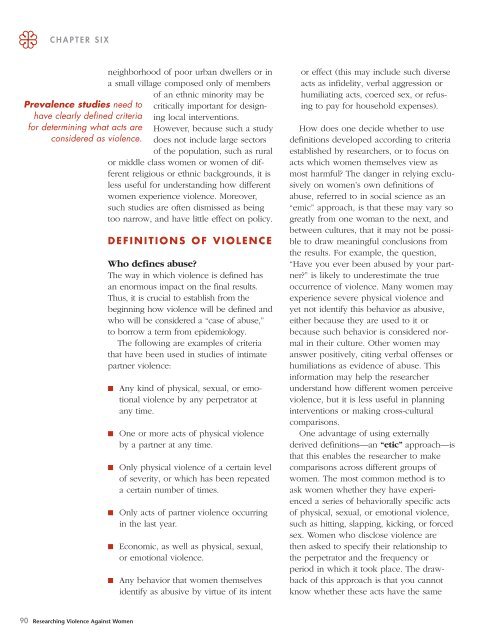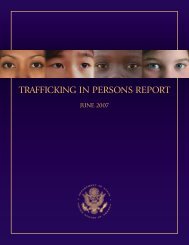Researching Violence Against Women: A Practical Guide for ... - Path
Researching Violence Against Women: A Practical Guide for ... - Path
Researching Violence Against Women: A Practical Guide for ... - Path
You also want an ePaper? Increase the reach of your titles
YUMPU automatically turns print PDFs into web optimized ePapers that Google loves.
CHAPTER SIX<br />
neighborhood of poor urban dwellers or in<br />
a small village composed only of members<br />
of an ethnic minority may be<br />
Prevalence studies need to critically important <strong>for</strong> designing<br />
local interventions.<br />
have clearly defined criteria<br />
<strong>for</strong> determining what acts are However, because such a study<br />
considered as violence. does not include large sectors<br />
of the population, such as rural<br />
or middle class women or women of different<br />
religious or ethnic backgrounds, it is<br />
less useful <strong>for</strong> understanding how different<br />
women experience violence. Moreover,<br />
such studies are often dismissed as being<br />
too narrow, and have little effect on policy.<br />
DEFINITIONS OF VIOLENCE<br />
Who defines abuse?<br />
The way in which violence is defined has<br />
an enormous impact on the final results.<br />
Thus, it is crucial to establish from the<br />
beginning how violence will be defined and<br />
who will be considered a “case of abuse,”<br />
to borrow a term from epidemiology.<br />
The following are examples of criteria<br />
that have been used in studies of intimate<br />
partner violence:<br />
■<br />
■<br />
■<br />
■<br />
■<br />
■<br />
Any kind of physical, sexual, or emotional<br />
violence by any perpetrator at<br />
any time.<br />
One or more acts of physical violence<br />
by a partner at any time.<br />
Only physical violence of a certain level<br />
of severity, or which has been repeated<br />
a certain number of times.<br />
Only acts of partner violence occurring<br />
in the last year.<br />
Economic, as well as physical, sexual,<br />
or emotional violence.<br />
Any behavior that women themselves<br />
identify as abusive by virtue of its intent<br />
or effect (this may include such diverse<br />
acts as infidelity, verbal aggression or<br />
humiliating acts, coerced sex, or refusing<br />
to pay <strong>for</strong> household expenses).<br />
How does one decide whether to use<br />
definitions developed according to criteria<br />
established by researchers, or to focus on<br />
acts which women themselves view as<br />
most harmful? The danger in relying exclusively<br />
on women’s own definitions of<br />
abuse, referred to in social science as an<br />
“emic” approach, is that these may vary so<br />
greatly from one woman to the next, and<br />
between cultures, that it may not be possible<br />
to draw meaningful conclusions from<br />
the results. For example, the question,<br />
“Have you ever been abused by your partner?”<br />
is likely to underestimate the true<br />
occurrence of violence. Many women may<br />
experience severe physical violence and<br />
yet not identify this behavior as abusive,<br />
either because they are used to it or<br />
because such behavior is considered normal<br />
in their culture. Other women may<br />
answer positively, citing verbal offenses or<br />
humiliations as evidence of abuse. This<br />
in<strong>for</strong>mation may help the researcher<br />
understand how different women perceive<br />
violence, but it is less useful in planning<br />
interventions or making cross-cultural<br />
comparisons.<br />
One advantage of using externally<br />
derived definitions—an “etic” approach—is<br />
that this enables the researcher to make<br />
comparisons across different groups of<br />
women. The most common method is to<br />
ask women whether they have experienced<br />
a series of behaviorally specific acts<br />
of physical, sexual, or emotional violence,<br />
such as hitting, slapping, kicking, or <strong>for</strong>ced<br />
sex. <strong>Women</strong> who disclose violence are<br />
then asked to specify their relationship to<br />
the perpetrator and the frequency or<br />
period in which it took place. The drawback<br />
of this approach is that you cannot<br />
know whether these acts have the same<br />
90 <strong>Researching</strong> <strong>Violence</strong> <strong>Against</strong> <strong>Women</strong>
















